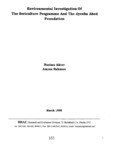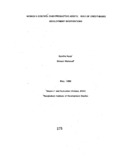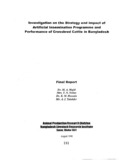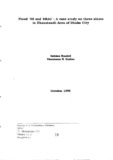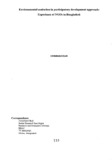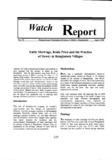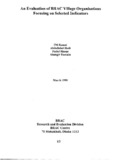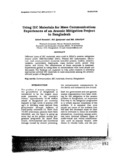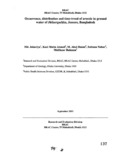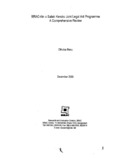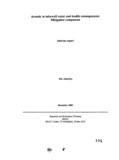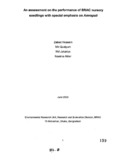BRAC: Recent submissions
Now showing items 141-160 of 939
-
Environmental investigation of The Sericulture Programme and The Ayesha Abed Foundation
(BRAC Research and Evaluation Division (RED), 1998-03)Objectives: Assessment of the potential environmental problems of the programme activities including environmental and health concerns, identify remedial measures to reduce the adverse impact on the environment and public ... -
The story of Khodeja: an entrepreneur par excellence
(BRAC Research and Evaluation Division (RED), 1998-06) -
Women's control over productive assets: role of credit-based development interventions
(BRAC Research and Evaluation Division (RED), 1998-05) -
Vegetable growers of BRAC and Flood 1998: a case study of Sonaidanga Balkuntthapur VO
(BRAC Research and Evaluation Division (RED), 1998-09)This study was conducted to know how the flood of 1998 affected the vegetable production of BRAG members and how they copped with the situation. The observation was conducted on 6 members of Sonaidanga Baikuntthapur VO ... -
Micro-credit programs, women's empowerment and change in nuptiality in Bangladesh villages
(BRAC Research and Evaluation Division (RED), 1998)Although the fertility impact of micro-credit and women's empowerment programs has received increasing attention in recent years, the role of credit-based income generating programs on nuptiality in traditional communities ... -
Investigation on the strategy and impact of artificial insemination programme and performance of Crossbred Cattle in Bangladesh
(BRAC Research and Evaluation Division (RED), 1998-08)This collaborative study was -sponsored by BRAC and executed by the Bangladesh Livestock Research Institute (BLRI), Savar with logistic and other support of the Department ofUvestock Services (DLS), GOB to investigate ... -
Flood '98 and BRAC - a case study on three slums in Dhanmandi area of Dhaka city
(BRAC Research and Evaluation Division (RED), 1998-10)This study is on Kathal Bagan, Bou Bazaar and Hazaribagh slums in Dhanmondi Area in Dhaka city of Bangladesh. It describes mainly the suffetings of the slum dwellers during floods, their coping strategy, the extent of ... -
Environmental sanitation in participatory development approach: experience of NGOs in Bangladesh
(BRAC Research and Evaluation Division (RED), 1998) -
Early marriage, bride price and the practice of dowry in Bangladesh villages
(BRAC Research and Evaluation Division (RED), 1998-04)This study estimates the incidence and correlates of early marriage and the practice of dowry in rural Bangladesh. Data for this research came from Watch, a surveillance system of BRAC covering 70 villages in I 0 regions ... -
Domestic violence against women: does development intervention matter?
(BRAC Research and Evaluation Division (RED), 1998-03) -
An evaluation of BRAC village organisations: focusing on selected indicators
(BRAC Research and Evaluation Division (RED), 1998-03)1. The study was based on a conceptual premise that BRAC's credit-plus approach not only helps improve economic condition of the rural poor by disbursing loan, but its group formation, conscietisation, skill training and ... -
Enrolment at primary level: gender difference disappears in Bangladesh
(International Journal of Educational Development, 2002-03)In the recent past, there have been a number of new initiatives to improve the access to primary education in many developing countries. Such initiatives, which came from the public, private and non-governmental (NGO) ... -
Using IEC materials for mass communication: experiences of an Arsenic mitigation project in Bangladesh
(BRAC Research and Evaluation Division (RED), 2003)Different types of lEC materials were used in BRAe's arsenic mitigation project (June 1999-December 2001). Printed lEC (Information. education. and communication) materials included posters. leaflets. stickers. booklets. ... -
Sustainable community- based safe water options to mitigate the Bangladesh arsenic catastrophe - an experience from two upazilas
(BRAC Research and Evaluation Division (RED), 2003-05)Sustainable community-based safe water options have been successfully operating in two upazilas involving 531 villages and encompassing a population of 497,488. Testing of tubewells for arsenic was carried out on a census ... -
Occurrence, distribution and time-trend of arsenic in ground water of Jhikorgachha, Jessore, Bangladesh
(BRAC Research and Evaluation Division (RED), 2003-09)In order to assess the arsenic concentration change over time, water from a total of 246 tubewells Jhikargachha upazila of Jessore district were tested using atomic absorption spectrophotometer in two different periods ... -
BRAC-Ain 0 Salish Kendro Joint Legal Aid Programme: a comprehensive review
(BRAC Research and Evaluation Division (RED), 2003-12)BRAC-Ain 0 Salish Kendro (ASK) joint legal aid programme was initiated to promote legal awareness among the poor along with providing them legal assistance to resolve their problems. This study intended to review BRAC-ASK ... -
Attitudes of the Elite Groups towards the ultra-poor: secondary stakeholders in the CFPR-TUP
(BRAC Research and Evaluation Division (RED), 2003)"Attitudes of the Elite Groups towards the Ultra-Poor Secondary stakeholders in the CFPR-TUP" was initiated as a combined effort between Advocacy and RED. Secondary stakeholders are those that beyond the primary stakeholders ... -
Assessment of environmental awareness of the students with primary education
(BRAC Research and Evaluation Division (RED), 2003-12) -
Arsenic in tubewell water and health consequences: mitigation component
(BRAC Research and Evaluation Division (RED), 2003-12) -
An assessment on the performance of BRAC nursery seedlings with special emphasis on Amrapali
(BRAC Research and Evaluation Division (RED), 2003-06)The study examined the performance of the three kinds of seedlings of BRAC nurseries named Amrpali, lemon, and guava. Interview was taken from those buyers who bought those seedlings from BRAG. A total of 153 buyers ...

